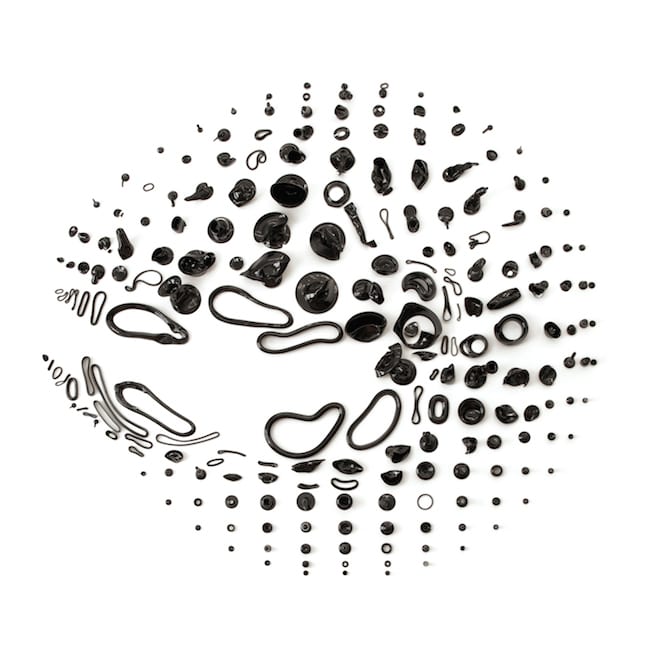Cathy Coëz is a multi-disciplinary French artist currently working in Brussels, Belgium who makes installations of objects to explore the human condition, language and art as artifact. She holds two MA fine arts degrees, from ENSAV Ecole Nationale Supérieure des Arts Visuels de La Cambre, Brussels – Belgium, and from ENSBA Ecole Nationale Supérieure des Beaux-Arts, Paris – France. She is a quickly-rising figure in contemporary ceramics, exhibiting most recently at the Jakarta Contemporary Ceramics Biennial in May, 2014.
Above Image: Cathy Coëz , Clay Drawing #21, 2012.
Coëz’s “Drawings” expose the essence of her conceptually-layered sculpture and are a clear entry point to exploring her expansive body of work. The three-dimensional Clay Drawings and Porcelain Drawings express her interest in material, artifact, narrative, and the intriguing balance of real-object versus representation. The drawings are made by creating objects out of clay, arranging them into a pattern, and then photographing the composition. As best exemplified in Clay Drawing #21 Coëz uses a pattern that appears to, and is, originally conceived from a digital program. The composition is not precise, but balances a precarious moment between mathematical and haphazardly arranged. Ironically, this nonchalant look actually requires careful precision in forms and placement – a sensitivity that is evident across her body of work.
The making of the piece A Hundred Tears began with Coëz asking 100 people “What is the last thing you cried for?” Each story was synthesized into a single word, which was then interpreted into a small representative ceramic object. This process very literally morphs spoken language into aesthetic objects – a universal language. In this way Coëz seems to be addressing the idea of “the perfect artifact” that can transcend time, culture, and language, because it is connected to the sensual essence of the human condition. This study of artifacts is also why ceramic, with its archival properties and rich history, is the ideal material for her work. You can scroll through all one hundred individual “tears” on her website.

Cathy Coëz , Clay Drawing #24, 2012
Coëz’s Wartime installation depicts a group of generic, almost sarcastically so, battle machines in a militaristic formation. Their surface is a high-gloss metallic black, not obviously ceramic, but visually more related to dense metal. This work exemplifies how Coëz’ sculpture maintains two existences: the now and the forever-after. Her work is designed into temporary installations for today’s audience. For instance, Wartime is most powerful in its collective installment, but the objects can function individually as iconic and meaningful things, showing that Coëz is possibly anticipating their inevitable separation. The same can be argued for A Hundred Tears in which the objects have specific narrative title-words attached to them. While very interesting now, those titles will certainly be lost over extended time with their sole communication becoming visual. The loss of the word-title and creation-narrative may diminish a portion of the conceptual content, but it does not compromise the pieces ability to communicate visually over the long-term. This calculated consideration for the future of her work, in material, theme, and language, is what gives Coëz’s sculpture a freshness and longevity that will allow it be contemplated and displayed for years (or centuries) to come.
Justin Crowe has joined CFile’s team as writer-at-large and will be reporting from Europe in the coming months.
Any thoughts about this post? Share yours in the comment box below.

Cathy Coëz , Clay Drawing #23, 2012

Cathy Coëz , A Hundred Tears, 2012

Cathy Coëz , A Hundred Traumas, 2012

Cathy Coëz , A Hundred Conversations, 2012

Cathy Coëz , A Hundred Realities, 2012

Cathy Coëz , Gold

Cathy Coëz , Portrait

Cathy Coëz , Wartime, 2010

Cathy Coëz , Wartime (detail), 2010

LOVE it! absolutely fascinating stuff. Thanks for the informative article!